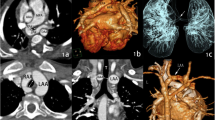Abstract
Background
The airway can become obstructed as a result of compression by an elongated aortic arch.
Objective
In this study we evaluated tracheal compression using multidetector-row CT in patients with congenital heart disease and an elongated aortic arch.
Materials and methods
The trachea was measured at the level of the aortic arch in 205 children and young adults and then the severity of tracheal compression was determined by measuring the tracheal diameter ratio (short axis diameter/long axis diameter). Patients were divided as follows: group I (normal aortic arch; n=166), group II (transversely running aortic arch; n=22), and group III (elongated aortic arch; n=17). From the viewpoint of the relationship of the great arteries, group II had D-malposition, and group III had L-malposition.
Results
Age, height, weight and body surface area were significantly correlated with the short and long axis diameter in group I. There was a negative correlation between tracheal diameter ratio and the physical size parameters. The tracheal diameter ratio in group III was 0.50±0.13, which was significantly lower than in groups I and II (P<0.01 and 0.05, respectively).
Conclusion
Even apparently asymptomatic patients with an elongated aortic arch can have tracheal compression. An elongated aortic arch may be a useful predictor of tracheal compression.





Similar content being viewed by others
References
Bové T, Demanet H, Casimir G et al (2001) Tracheobronchial compression of vascular origin. Review of experience in infants and children. J Cardiovasc Surg (Torino) 42:663–666
Sebening C, Jakob H, Tochtermann U (2000) Vascular tracheobronchial compression syndromes – experience in surgical treatment and literature review. Thorac Cardiovasc Surg 48:164–174
Yamagishi H, Maeda J, Higuchi M et al (2002) Bronchomalacia associated with pulmonary atresia, ventricular septal defect and major aortopulmonary collateral arteries, and chromosome 22q11.2 deletion. Clin Genet 62:214–219
McElhinney DB, Reddy VM, Pian MS et al (1999) Compression of the central airways by a dilated aorta in infants and children with congenital heart disease. Ann Thorac Surg 67:1130–1136
Kim YM, Yoo SJ, Kim TH et al (2001) Tracheal compression by elongated aortic arch in patients with congenitally corrected transposition of the great arteries. Pediatr Cardiol 22:471–477
Kim YM, Yoo S-J, Kim WH et al (2002) Bronchial compression by posteriorly displaced ascending aorta in patients with congenital heart disease. Ann Thorac Surg 73:881–886
Goo HW, Park IS, Ko JK et al (2005) Computed tomography for the diagnosis of congenital heart diseases in pediatric and adult patients. Int J Cardiovasc Imaging 21:347–365
Chen SJ, Shih TT, Liu KL et al (2004) Measurement of tracheal size in children with congenital heart disease by computed tomography. Ann Thorac Surg 77:1216–1221
Chen SJ, Lee WJ, Wang JK et al (2003) Usefulness of three-dimensional electron beam computed tomography for evaluating tracheobronchial anomalies in children with congenital heart disease. Am J Cardiol 92:483–486
Hayabuchi Y, Mori K, Kitagawa T et al (2007) Polytetrafluoroethylene graft calcification in patients with surgically repaired congenital heart disease using multidetector-row computed tomography. Am Heart J 153:806.e1–e8
Hayabuchi Y, Mori K, Kitagawa T et al (2007) Accurate quantification of pulmonary artery diameter in patients with cyanotic congenital heart disease using multidetector-row computed tomography. Am Heart J 154:783–788
Lee SL, Cheung YF, Leung MP et al (2002) Airway obstruction in children with congenital heart disease: assessment by flexible bronchoscopy. Pediatr Pulmonol 34:304–311
Robotin MC, Bruniaux J, Serraf A et al (1996) Unusual forms of tracheobronchial compression in infants with congenital heart disease. J Thorac Cardiovasc Surg 112:415–423
Lambert V, Sigal-Cinqualbre A, Belli E et al (2005) Preoperative and postoperative evaluation of airways compression in pediatric patients with 3-dimensional multislice computed tomographic scanning: effect on surgical management. J Thorac Cardiovasc Surg 129:1111–1118
Thomas KE, Wang B (2008) Age-specific effective doses for pediatric MSCT examinations at a large children’s hospital using DLP conversion coefficients: a simple estimation method. Pediatr Radiol 38:645–656
Tsai IC, Chen MC, Jan SL et al (2008) Neonatal cardiac multidetector row CT: why and how we do it. Pediatr Radiol 38:438–451
Griscom NT (1982) Computed tomographic determination of tracheal dimensions in children and adolescents. Radiology 145:361–364
Author information
Authors and Affiliations
Corresponding author
Rights and permissions
About this article
Cite this article
Watanabe, N., Hayabuchi, Y., Inoue, M. et al. Tracheal compression due to an elongated aortic arch in patients with congenital heart disease: evaluation using multidetector-row CT. Pediatr Radiol 39, 1048–1053 (2009). https://doi.org/10.1007/s00247-009-1319-1
Received:
Revised:
Accepted:
Published:
Issue Date:
DOI: https://doi.org/10.1007/s00247-009-1319-1




